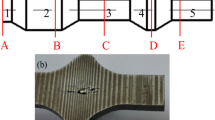Abstract
In this paper, a thermal–mechanical coupled simulation model for two-roll cross wedge rolling (CWR) was developed to investigate the influence of cooling condition of tools on central deformation of workpiece and tool wear by using three-dimensional rigid-plastic finite element method. Based on the simulation results, the information about central deformation of workpiece and tool wear with and without tool cooling was compared and analyzed. The study results indicate that forging quality and tool life can be improved by means of cooling the tools with cooling water. Subsequently, an industrial example of CWR in blank forming for engine connecting rod was presented to verify the feasibility of study results. In this industrial application, higher forging quality and longer tool life were obtained, which benefits the decrease of production cost. This study provides insights into the mechanisms of central deformation of workpiece and tool wear under different cooling conditions of tools in CWR process as well.
Similar content being viewed by others
References
Song YQ, Wang MH, Li ZG (2010) One-way successive plate cross wedge rolling machine. Sci China Tech Sci 53(1):164–167
Li Q, Lovell MR (2004) The establishment of a failure criterion in cross wedge rolling. Adv Manuf Technol 24:180–189
Johnson GR, Mamalis AG (1997) A survey of some physical defects arising in metal forming processes. In: Proceedings of the 17th International MTDR Conference, London, U.K.
Fang G, Lei LP, Zeng P (2002) Three-dimensional rigid-plastic finite element simulation for the two-roll cross-wedge rolling process. J Mater Process Tech 129:245–249
Wang MT, Li XT, Du FS, Zheng YZ (2005) A coupled thermal-mechanical and microstructural simulation of the cross wedge rolling process and experimental verification. Mater Sci Eng 391:305–312
Dong Y, Tagavi KA, Lovell MR (2000) Analysis of interfacial slip in cross-wedge rolling: a numerical and phenomenological investigation. J Mater Process Tech 97:44–53
Bartnicki J, Pater Z (2005) Numerical simulation of three-rolls cross-wedge rolling of hollowed shaft. J Mater Process Tech 164–165:1154–1159
Pater Z (2000) Theoretical and experimental analysis of cross wedge rolling process. Int J Mach Tools Manuf 40:49–63
Li Q, Lovell MR (2003) Predicting critical friction in a two-roll cross wedge rolling process. J Tribol 125:200–203
Li Q, Lovell MR (2005) On the critical interfacial friction of a two-roll CWR process. J Mater Process Tech 160:245–256
Li Q, Lovell MR, Slaughter W, Tagavi K (2002) Investigation of the morphology of internal defects in cross wedge rolling. J Mater Process Tech 125–126:248–257
Wang MT, Li XT, Du FS, Zheng YZ (2005) Hot deformation of Austenite and prediction of microstructure evolution of cross-wedge rolling. Mater Sci Eng 379:133–140
Wang MT, Li XT, Du FS (2009) Analysis of metal forming in two-roll cross wedge rolling process using finite element method. J Iron Steel Res Int 16:38–43
Kchaou M, Elleuch R, Desplanques Y, Boidin X, Degallaix G (2010) Failure mechanisms of H13 die on relation to the forging process—a case study of brass gas valves. Eng Fail Anal 17:403–415
Archard JF (1953) Contacts and rubbing of flat surface. J Appl Phys 24:981–988
Chevalier L, Cloupet S, Soize C (2005) Probabilistic model for random uncertainties in steady state rolling contact. Wear 258:1543–1554
Kim DH, Lee Y, Kin BM (2002) Application of ANN for the dimensional accuracy of workpiece in hot rod rolling process. J Mater Process Tech 130–131:214–218
Dirks B, Enblom R (2011) Prediction model for wheel propfile wear and rolling contact fatigue. Wear 217:210–217
Enblom R, Berg M (2005) Simulation of railway wheel profile development due to wear-influence of disc braking and contact environment. Wear 258:1055–1063
Jendel T (2002) Prediction of wheel profile wear-comparisons with field measurements. Wear 253:89–99
Li ZL, Kalker JJ (1998) Simulation of severe wheel-rail wear. Comput Railways VI 2:393–402
Jensen MR, Damborg FE, Nielsen KB, Dancert J (1998) Applying the finite element method for determination of tool wear in conventional deep drawing. J Mater Process Tech 83:98–105
Wang KS, Liu QK, Zhang DY (2009) Numerical simulation of the tribological behaviour of the serial coatings of D2 steel. Acta Physica Sinica 58:89–93
Brucelle O, Bernhart G (1999) Methodology for service life increase of hot forging tools. J Mater Process Tech 87:237–246
Jung I, Lubich V, Wieland HJ (2002) Tool failure – causes and prevention. In: 6th International tooling conference, Sweden
Persson A, Hogmark S, Bergstrom J (2005) Thermal fatigue cracking of surface engineered hot work tool steels. Surf Coat Tech 191:216–227
Author information
Authors and Affiliations
Corresponding author
Rights and permissions
About this article
Cite this article
Wang, M., Xiang, D., Xiao, C. et al. Influence of cooling condition of tools on central deformation of workpiece and tool wear in cross wedge rolling. Int J Adv Manuf Technol 59, 473–482 (2012). https://doi.org/10.1007/s00170-011-3537-6
Received:
Accepted:
Published:
Issue Date:
DOI: https://doi.org/10.1007/s00170-011-3537-6



